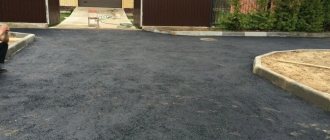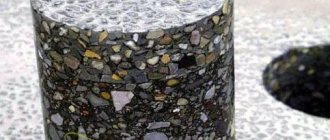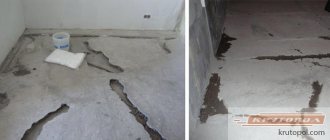Asphalt is the most popular method used to cover roads and sidewalks. The demand for the material is explained by its unique physical and chemical properties. Asphalting the road surface is a practical modern solution that is lightweight (when compared with other types of coating, for example, laying tiles). Properly laid asphalt, subject to asphalt laying technology in accordance with GOST, is resistant to adverse climatic factors, characterized by wear resistance and a long service life.
Methods of laying asphalt
Cold paving
In cold asphalting, the mixture is based on liquid petroleum road bitumen. The peculiarity of the work is that installation is possible only in the warm season. This is because the water drying step is not used. This paving method is well suited for pothole repair.
Hot paving
During hot asphalt paving, the main components of the mixture are liquid and viscous petroleum bitumen. The peculiarity of installation is that work can be carried out in winter, when it is cold outside. In order for the asphalt coating to be durable, the temperature of the asphalt during laying according to GOST must be at least 120 degrees . The area where asphalt is planned to be laid is pre-dried using special equipment.
Repair work
Even well-laid asphalt will someday begin to deteriorate. This process will be caused by physical activity and sunlight. This coating can be repaired.
The following restoration technologies can be used for repairs:
- Sealing cracks with tar. The crack is cleaned, covered with sand and filled with tar, after 15 minutes the asphalt is leveled with a spatula.
- Laying rolls of finished asphalt on the old one. The layer freed from the protective film is located above the damaged area and pressed tightly.
- Using cold asphalt. In the area of damage, the prepared mixture must be laid out on the old asphalt, leveled and compacted.
Such work must be carried out regularly, then the coating will last a long time. If we are talking about main highways, then SNiP recommends that the canvas be changed completely.
Stages of laying asphalt
Design and estimate documentation is being developed
The project must be developed taking into account the characteristics of the site , which has its own individual characteristics (type of relief, parameters, soil structure). After the specialist’s calculations, an estimate , which takes into account:
- plot size,
- volume of work,
- preliminary cost.
The location of underground communications is also included in the calculation. This is necessary for the correct calculation of the drainage system, which will help avoid problems with wastewater disposal in the future.
Due attention should be paid to the root system of large trees, as over time the roots can grow and seriously damage the road surface.
Excavation
Preparatory work begins. First of all, the top layer of soil is removed. If the task is to remove a large layer, the use of specialized equipment - bulldozers and loaders - is required. The territory is leveled using graders. Subsequently, a road “trough” is formed, which will undergo further compaction.
How deep to dig? First of all, the indicator depends on the purpose of the roadway. To lay paths, it is enough to remove 15-25 cm of soil. The rule applies here: the greater the planned load on the canvas, the deeper the pit is dug.
Important! The project should be designed so that rainwater flows into the drainage system and does not accumulate on or under the asphalt surface.
If the work is not done from scratch, the existing coating is destroyed using a road router. Obsolete coating can be reused if recycled correctly.
Do you want to buy sand or crushed stone with delivery?
Call now and get a discount +7 (988) 318-84-49
The foundation is being prepared
At this stage, a “road cushion” is formed. The task is to pour two layers of the road “pie”:
- Sand or gravel-sand mixture is laid.
- To give strength, the top of the coating is sprinkled with coarse crushed stone.
- To minimize voids, the cake is additionally covered with crushed stone with a fine fraction.
To ensure that the coating does not lose its quality characteristics over time, each layer must be leveled using a grader and carefully compacted. Side stone is used to fence off an asphalted area.
Important! To give the coating maximum strength, the surface should be impregnated with bitumen before paving.
Scheme of the correct road “pie”
Laying asphalt
The final stage. If the material is not prepared directly on site, delivery is carried out using dump trucks. Sand, mineral powder, liquid bitumen and crushed stone are the key components of ABS (asphalt concrete mixture) .
When applying the mixture, it is important that it spreads evenly. To avoid uneven surfaces, they use asphalt pavers. To increase the density of the coating, laying is carried out with several rollers. It is recommended to use equipment that is specifically designed for each individual type of work. Only in this case the coating will be of high quality.
Road Pie Construction Technology
Regardless of the nature of the work (you will make a road from scratch or just repair the road), you must follow the sequence and technical requirements for building a road pie:
- Stage 1 - cut off the fertile layer of soil and remove all garbage;
- Stage 2 - the roadbed is compacted and compacted using special equipment;
- Stage 3 - geotextiles are applied to the road foundation layer (the strength of the highway to displacement and erosion by moisture directly depends on it);
- Stage 4 - formation of a sand cushion to reduce the deformation of the road surface);
- Stage 5 - covered with crushed stone;
- Stage 6 - fixing road surfaces with bitumen emulsion;
- Stage 7 - applying asphalt coating in several layers.
GOST – laying asphalt in Russia. Download GOST R 54401-2011
The main document regulating asphalt laying (road paving) in Russia is the state standard GOST R 54401-2011 Public automobile roads. Hot cast road asphalt concrete. Technical requirements.
The national standard of the Russian Federation applies to hot cast road asphalt concrete and hot cast asphalt road mixtures (hereinafter referred to as cast mixtures) used for the construction of pavements on public roads, bridge structures, tunnels, as well as for pothole repairs, and establishes technical requirements to them.
Classification
All asphalt mixtures are divided into three classes based on the grain size of the mineral components.
The first class is large grains. The largest of them can reach four centimeters. Material of this caliber is suitable for laying routes. It is able to withstand the movement of a large number of trucks.
The second class is medium grains. Their largest size can be 25 millimeters. This material is used to improve pedestrian streets and squares.
The third class is small grains. The particles of the mixture in this case do not exceed a size of fifteen centimeters. The fine fraction allows the grains to adhere tightly to each other. Therefore, during the compaction process, the surface turns out to be perfectly flat. This type of coating is suitable for landscaping courtyards and sports grounds.
Asphalt paving equipment
At all stages of asphalt paving, special road construction equipment is used. It not only speeds up the process of laying the road surface significantly, but also significantly improves the final quality of all work. Below is all the necessary equipment for asphalt paving:
Bulldozer
A bulldozer is a self-propelled road construction machine with cyclic action. Equipped with a knife working body. Main purpose: carrying out excavation and transport work.
Bulldozers are widely used and are intended for all stages of construction work:
- to prepare the soil base,
- to apply a sand and crushed stone layer,
- to prepare the road base for asphalting.
Bulldozers are either tracked or wheeled. Crawler bulldozers are designed for work in off-road and difficult terrain conditions and have great power and endurance.
Wheeled bulldozers have lower productivity, but are characterized by high maneuverability. Can work in small areas. They are used for constructing road bases, while tracked ones are better suited for earthmoving work.
Loader
The loader is a self-propelled or manual machine. The main purpose is to lift, transport and stack heavy loads.
Bucket loaders are also divided into tracked and wheeled. The former have greater power, productivity and endurance, the latter are intended for simple work in small areas.
Loaders are universal equipment because they can be equipped with a wide variety of attachments:
- bulldozer blades,
- ladle,
- scraper working bodies, etc.
This technique is used for laying asphalt concrete pavement and subsequent cleaning of the area from construction debris, and, if necessary, fallen leaves, snow, branches, etc.
Grader
The main purpose of the grader is planning and profiling the work area. This is a self-propelled or trailed machine that is used to level the soil and then move it. It is also used for cleaning areas from loose construction materials and snow.
Asphalt concrete paver
An asphalt concrete paver is a type of construction equipment that can be tracked or wheeled. The asphalt concrete paver is designed for laying asphalt concrete mixtures. Depending on the type of work to be done (their volume and complexity), machines can be heavy or light. Large equipment is needed at large road construction sites, while light equipment is used for auxiliary work.
Using tar concrete mixture
Much less often, for the construction of asphalt concrete road surfaces, tar and concrete mixtures are used, to which coal tar is added for viscosity. This type of coating is almost no different in appearance from classic asphalt concrete. Tar concrete mixture is more wear-resistant and deteriorates faster from temperature changes and exposure to water. In addition, it is quickly erased under the influence of rubber tires of vehicles.
Tar concrete is prohibited from being used in cities, since the fumes of light fractions of tar are harmful to humans. In addition, under the influence of water, phenols are soaked out of such asphalt, which are harmful to humans and the environment.
What equipment is used when paving roads?!
All the equipment presented above is used when paving roads. To properly lay asphalt and give it strength and durability, you need to carefully follow all the stages of laying the pavement and use specialized equipment. Only a heavy machine is capable of compacting layers of asphalt concrete pavement well in order to minimize voids and provide the road surface with high density.
High-quality step-by-step execution of all work guarantees the coating high performance properties and a long service life.
Ours offers you rental services for a soil vibratory roller and other special equipment needed at different stages of work on laying a new road surface at low prices. We also offer supplies of inert materials to construction sites.
Call now and get a discount or send a request to This email address is being protected from spambots. You must have JavaScript enabled to view it.
Video - Correct asphalt laying technology
Video – Modern asphalting technologies
Mixing processed components
After pre-treatment, crushed stone and sand enter the conveyor, from where they are transported to a bunker and then mixed with bitumen. After this, the temperature in the bunker is raised to 160 degrees and the contents are left heated for storage for up to 4 days. If the material is not shipped to the consumer within this period, it will begin to lose its strength characteristics.
Additives to asphalt and crumb rubber are added to the finished and heated mixture, which gives the material additional strength and resistance to external factors.
About defects in asphalt pavement and ways to eliminate them
Now let's look at what defects can appear on an asphalt pavement, understand the reasons for their appearance and how to eliminate them.
- Short waves repeating every half meter. In this case, most likely, the composition is unevenly supplied to the paver screw feeders. As a result, the pressure of the screed plate on the surface is constantly changing. To eliminate the flaw, you need to carefully inspect the paver's power supplies and the screed itself. It is also necessary to pay attention to the temperature of the composition and its stability.
- Long type waves. Such defects arise due to fluctuations in the composition and its temperature. Also, the reason may lie in sudden changes in the movement of the skating rink. In addition, this flaw may be a reflection of the unevenness of the base itself. The defect is eliminated by monitoring the operation of the laying mechanisms and the quality of the working composition.
- Gaps in the middle of the laid layer, along its edges and across the entire surface. The culprit here is most likely the asphalt paver itself, or rather its screed. Also, deformation of the coating can occur due to the low temperature of the working composition and the presence of foreign components in it. Breaks can be eliminated by strictly monitoring the operation of the laying equipment. Single breaks can only be patched by pouring hot mixture directly in front of the road roller.
- Uneven surface texture. This defect appears due to the fact that the composition delaminates, its temperature decreases, or it is simply supplied incorrectly to the paver. To eliminate the defect, you need to determine the cause of its occurrence and monitor the operation of the asphalt paver.
- Cracking. This defect may appear at the very beginning of the rolling process. The problem may lie in the excessive plasticity of the composition or its high temperature. Less commonly, the surface cracks due to the large temperature difference between the mixture and the base. In this case, the asphalt composition is checked and adjusted, and the compaction regime is adjusted. Replacing the links of road rollers may also help.
- Bitumen stains on the surface. This flaw occurs at the very beginning of operation. This can make the surface more slippery, especially if it rains. The reason for this defect is too much bitumen in the mixture, its separation, and the presence of water in it. It is possible that there is too much bitumen in the base itself. This drawback can be eliminated by controlling the level of moisture and bitumen in the mixture and changing its composition. As a last resort, greasy stains can be sprinkled with fine sand.
- Poor quality of seams in contact between strips. Such a nuisance can occur if installation rules are not followed. Naturally, it is eliminated by strict adherence to the technology of laying asphalt pavement. Experts also recommend heating cold joints with gas burners and then rolling them with a roller.
- Uneven layer thickness. This type of defect occurs either because the screed is not adjusted or because the paver itself was driving too fast. In this case, it is necessary to adjust the operation of the asphalt paving machine.
- Longitudinal cracks. A flaw of this kind occurs due to the fact that the bottom layer is poorly compacted. When the roller moves, this layer moves. As a result of this, cracks appear. The defect can be eliminated only partially, and then while the mixture has not yet cooled.










